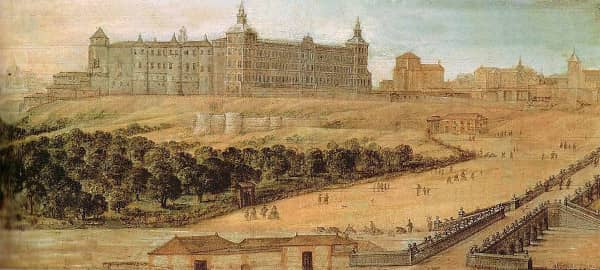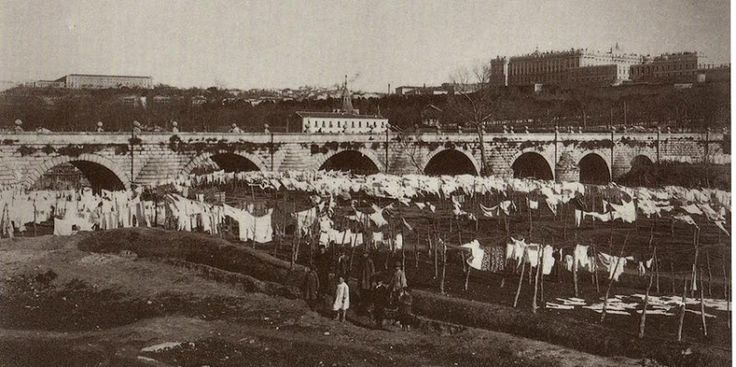
The Puente de Segovia : Madrid’s Oldest Bridge
Stately and understated, the Puente de Segovia stands as one of Madrid’s most remarkable architectural treasures.
With its nine elegant arches and solid stonework, this bridge gratefully spans the Manzanares River, bridging the gap between the city’s past and present. Just imagine the countless stories a bridge could tell, having watched Madrid evolve over centuries. It holds a fascinating legacy: ¡It is the oldest bridge in the capital! A silent witness to the passage of time and a meeting point where history and the urban landscape come together.
Back in 1561, when Philip II moved his court to Madrid, the city experienced an unprecedented growth, making better infrastructure an absolute necessity. To facilitate trade and enhance connections with other regions, particularly those in the north, construction of the bridge was approved in 1574, with a budget of 200,000 ducats. The project began under the supervision of royal architect Gaspar de Vega, but following his death in 1577, the task was handed over to none other than Juan de Herrera, the mastermind behind El Escorial. With his unmistakable Herrerian style, inspired by the Renaissance, Herrera brought the project to completion, and the bridge was officialy inaugurated in 1584 as a symbol of Madrid’s growing power and modernization as the capital of the Spanish Empire.

Strolling around the Puente de Segovia is like stepping into a time machine. Over the centuries, it has seen everything: historical milestones, conflicts, celebrations, and the daily hustle and bristle of Madrid’s people. For generations, washerwomen of all ages gathered along the riverbanks, creating a maze of clotheslines filled with white linens drying in the sun, as children played nearby and makeshift wooden walkways allowed people to hop across the shallow river from islet to islet. Thanks to the rise of photography in the 19th century, we have images capturing these scenes,revealing a lively riverside world filled with street vendors selling churros, small vegetable gardens and wooden walkways allowing people to hop across the shallow river from islet to islet.

Madrid has never been known for its river, and the humble Manzanares has been the subject of jokes for centuries. Spain’s Golden Age playwrights couldn’t resist poking fun at the grandeur of the bridge in contrast to the river’s modest flow.
The Puente de Segovia was not immune from the ravages of the Spanish Civil War. In an attempt to stop the advance of General Yagüe’s Nationalist troops, the Republican side blew up the structure,leaving it unusable until the conflict ended. In the post-war years, the engineer Vicente Olmos expanded its width to the current 31 meters. In the late 20th century, with the construction and underground rerouting of the M-30 highway, the bridge was fully integrated into the Madrid Río park, transforming it into a peaceful green where locals and visitors alike can stroll, and enjoy a breath of fresh air.

The bridge also holds some fascinating curiosities. Originally, it was called La Puente Segoviana, since in that era, the word puente was grammatically feminine in Spanish. Another remarkable anecdote is the tale of the “killer sphere.” One stormy day, a fierce windstorm dislodged one of the stone spheres adorning the bridge. Tragically, it struck and killed a passerby. In a bizarre twist of fate, the judge on duty ordered the sphere’s arrest, and it was taken into custody in the courtyard of the Casa del Verdugo next to the Cárcel de la Corte—now the Palace of Santa Cruz and the Ministry of Foreign Affairs. This peculiar punishment wasn’t uncommon at the time, as it was not uncommon to sentence animals or inanimate objects that had caused harm, as chronicler Pedro de Répide documented.
Today, the Puente de Segovia is much more than a relic of the past. Declared a Bien de Interés Cultural (Asset of Cultural Interest) in 1996, it has become an iconic part of Madrid’s La Latina district. Surrounded by lush green spaces it offers a scenic route linking the Royal Palace and Almudena Cathedral. Whether for a stroll or a bike ride, it offers breathtaking views of Madrid’s skyline from a uniquely historic vantage point.

If you’re keen to uncover more stories like this or truly get to know the city that this bridge has watched grow, join one of our Free Tour Madrid from Monday to Saturday in the heart of Madrid or whenever you want in our Private Tour Madrid . We look forward to exploring the city’s living history with you !